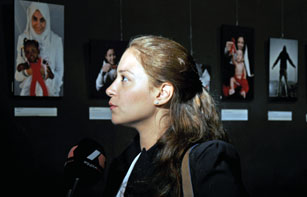
Visitors to the Positive Faces photo exhibition.
To highlight the power of people to create social change including ending HIV-related stigma, a photography exhibition has opened in Cairo. It displays a combination of portraits from the Egyptian revolution that took place in January 2011 and portraits submitted to a World AIDS Day photo contest in 2010 by young photographers under the theme Positive Faces.
It has been 30 years since a grassroots movement of activists mobilized in response to HIV that was impacting their communities. They had no money and even less recognition from the world but with courage and strong belief in their cause they made, and continue to make, a difference for people infected with and affected by HIV. Now, a photo exhibition brings together two movements led by anonymous individuals and communities that share a call for equity and justice.
The exhibition, co-organized by UNAIDS and Sawy Cultural Wheel, opened on 11 May and will run until 21 May at the Cultural Centre in central Cairo. It borrows from the spirit of the Egyptian revolution to extend dignity and freedom to people living with HIV and affected communities.
I hope that people living with HIV in the country realize they have the power to make a difference, to help themselves and others by speaking up for their rights
Menna Shalabi, UNAIDS National Goodwill Ambassador for Egypt
The launch event included a discussion forum with panellists Menna Shalabi, UNAIDS National Goodwill Ambassador for Egypt; the photographer Mr Monir El Shazly; and Dr Mohamed Slalah, President of the International Federation of Medical Students Association in Egypt.
While Dr Slalah underlined the role of art in communicating messages to promote social justice and human rights, Ms Shalaby drew from her personal engagement with people living with HIV to emphasize that people can get trapped by feelings of disempowerment. “I hope that people living with HIV in the country realize they have the power to make a difference, to help themselves and others by speaking up for their rights,” she said.

Menna Shalabi, UNAIDS National Goodwill Ambassador for Egypt at the launch of the photo exhibition.
Mr Shazly, who is a professional photographer of note, commented that the photographs were so expressive and profound that they communicated to both the heart and mind. In his opinion, the sense of solidarity around a common cause is what drove the popular uprising and revolution in Egypt. “The HIV response needs to solicit the same sense of unity and people living with HIV should realize they have the power to make that happen,” he said.
Wessam El Beih, UNAIDS Country Officer Egypt explains that the idea to combine photographs was, “to emphasize that overcoming the fear and silence barrier is key to galvanize action that brings about change and the realization of rights.”
Three winners of the 2010 HIV photo contest were presented with digital cameras sponsored by Canon during the launch. The first prize winner, Dina Ezzat, explained that her child was the inspiration behind her photograph. According to Ms Ezzat, the image of a baby wrapped in a red ribbon symbolizes that the future can be bright and free from HIV, and that there is an obligation for society to protect that future through an effective AIDS response.





